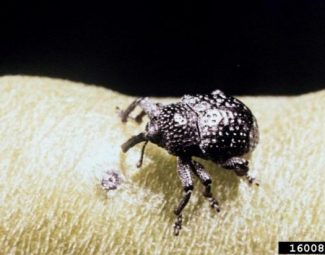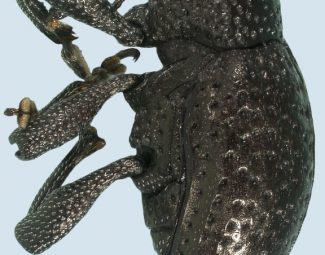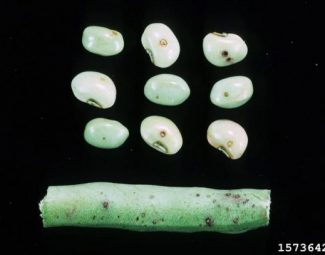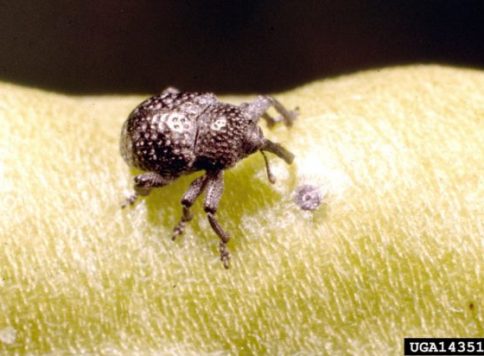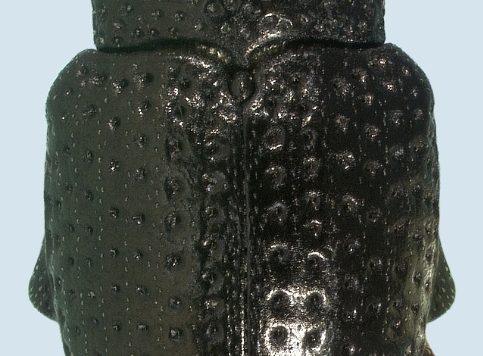Cowpea Curculio
Insect Summary Report
Chalcodermus Aeneus
General Information
- Cowpea Cucurlio primarily feed on various legumes, but can be found on cotton, soybean, and strawberry.
- Can survive on several weed hosts, including: cutleaf evening primrose, moss verbena, wild bean, purple cudweed, heartwing sorrel, sheep sorrel, and spring vetch.
- Cowpea is the preferred host.
- Primary source of economic damage is due to larval feeding of seeds inside pods.
- Infestation seen as small, brown, blisters on outside of pods.
- Pheromone activity unknown.
Life Cycle (30-40 Days)
- Eggs… (3-6 days) Deposited inside bean pod after hole is made by adult proboscis. Egg is white in color and oval in shape. Female deposits average of 112 eggs over 45 day period.
- Larva… (6-10 days) 4 instars. Pale yellow in color and reaches approx. 7mm in length. Center of body is thicker than either end and has deep furrows on the back. Develops inside pod and feeds on seeds.
- Pupa… (5-19 days) After full development, larva emerges from pod and drops to soil where it pupates. Pupa is yellowish-white in color and resembles adult in appearance and shape. Will remain in soil after transformation to adult until outer shell hardens (about 2 days).
- Adult… Black, 4.8-5.5 cm. Oval in body structure with distinctive long proboscis used for feeding and penetrating bean hull for egg insertion. Most active during morning and early evening and seek shelter from the heat during the hottest part of the day. Can fly, but rarely do so.
Over-wintering Strategy
Over-winter as adults in crop refuse, grass, or insulating material outside of fields. Emerge in April-May.
Organic Control
- General Info
- Myiophasia globosa has been shown to be an abundant parasitoid, but is unavailable for commercial purchase(2010).
- Fire ants have been shown to significantly affect pupal survival.
- Tachnid flies are natural parasites of the cowpea curculio.
- Commonly Used Products
- Cocoon (Kaolin)
- Pyganic 1.4 (Botanical)
- Pyganic 5.0 (Botanical)
- BoteGHA ES (soil or foliar application)
- Mycotrol ESO (soil or foliar application)
- Ferti-Neem Oil
- Ferti-Organics Karanja Oil
- Biorepel (Garlic Oil)
- Neemix 4.5 (Botanical)
Note: Treatment of mature pods has not proven to have significant effect on yield.
Cultural Control
- Because the adult rarely flies, but reaches its host plant principally by walking, crop rotation is beneficial.
- Crop rotation to crops that are not hosts of bean curculio.
- Tillage and destruction of host crop soon after harvest.
- Destruction of alternative weed and crop hosts.
- Sanitation of potential over-wintering debris.
More Images of the Cowpea Curculio
Bibliography
- Images by Clemson University – USDA Cooperative Extension Slide Series, Bugwood.org (adult on common bean, adult puncturing common bean)
- Images by Natasha Wright, Cook’s Pest Control, Bugwood.org (lateral and dorsal view of adult)
- Image by John C. French Sr., Retired, Universities:Auburn, GA, Clemson and U of MO, Bugwood.org (darker adult on bean)
- Images by Gerald Holmes, California Polytechnic State University at San Luis Obispo, Bugwood.org (feeding damage on pod and peas)
- http://www.bugwood.org/factsheets/99-011.html (General Information, overwintering stategy, natural enemies)
- http://creatures.ifas.ufl.edu/veg/bean/cowpea_curculio.html (Life cycle, natural enemies)
- Russell CE. 1981. Predation on the cowpea curculio by the red imported fire ant. Journal of the Georgia Entomological Society 16: 13-15
- Daoust RA, Pereira RM. 1986. Survival of Beauveria bassiana (Deuteromycetes: Moniliales) conidia on cadavers of cowpea pests stored outdoors and in laboratory in Brazil. Environmental Entomology 15: 642-647.
- Sudbrink Jr DL, Mack TP, Zehnder GW. 1998. Alternate host plants of cowpea curculio, (Coleoptera: Curculionidae) in Alabama. Florida Entomologist 81: 373-383.

